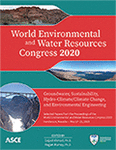World Environmental and Water Resources Congress 2020
Behavior of Salt Transport and Submarine Groundwater Discharge between an Estuary and the Underlying Coastal Aquifer
Publication: World Environmental and Water Resources Congress 2020: Groundwater, Sustainability, Hydro-Climate/Climate Change, and Environmental Engineering
ABSTRACT
Coastal aquifers usually act as a source of freshwater received from terrestrial sources and supplied to the overlying estuaries in the form of submarine groundwater discharge (SGD). Those aquifers act also as a sink of salt fluxes received from the estuary. Heavier saline estuarine water underlain by a less dense terrestrial-based fresh groundwater results in an unstable flow and salt transport condition. Exchange of freshwater and saline fluxes between the aquifer and the estuary may have significant impacts on the estuarine ecosystem and therefore, it is important to be understood. Two numerical models were developed using SEAWAT to study the behavior of SGD and salt exchange at two transects across the Indian River Lagoon. Field data revealed that the normalized IRL salinity can vary from freshwater salinity of 0.3 to that of ocean salinity of 1, based on ocean salinity of 35 g/L. Results obtained from model simulations showed that a transition mixing zone of brackish water exists below the estuary. Salt fluxes are found to migrate from the estuary down into the aquifer even though SGD is discharging upward from the aquifer into the lagoon. Higher IRL salinity was found to cause more salt transported into the aquifer and lower SGD into the lagoon. Regression analysis revealed a straight-line correlation (r2 =1) between increasing IRL salinity and decreasing SGD. Spatial distribution of the SGD below the lagoon obtained from the numerical models showed that the SGD occurs across the entire transect with the majority being received from the mainland.
Get full access to this article
View all available purchase options and get full access to this chapter.
REFERENCES
Al-Taliby, W, Pandit, A, Heck, H (2017) “Comparison of Seepage Simulation in a Saline Environment below an Estuary Using MODFLOW and SEAWAT.” Hydrol Current Res, (8)270.
Belanger, TV, and Walker, RB. (1990). “Groundwater seepage in the Indian River Lagoon, Florida in tropical hydrology and Caribbean Islands Water Resources.” Proceedings of the International Symposium on Tropical Hydrology and Fourth Caribbean Islands Water Resources Congress. Water Resource. Assoc; 367-375.
Cable, JE, Martin, JB, Swarzenski, PW, Lindenburg, M, and Steward, J. (2004). “Advection within shallow pore waters of a coastal lagoon.” Ground Water, 42, 1011-1020.
Guo, W, Langevin, CD (2002). “User's Guide to SEAWAT: A Computer Program for Simulation of Three-Dimensional Variable-Density Ground-Water Flow.” Techniques of Water-Resources Investigations 6-A7, U.S. Geological Survey, Tallahassee, FL.
Martin, JB, Cable, JE, Smith, C, Roy, M, and Cherrier, J. (2007). “Magnitudes of submarine groundwater discharge from marine and terrestrial sources: Indian River Lagoon, Florida.” Water Resource Research, 43.
Martin, JB, Cable, JE, Swarzenski, PW, and Lindenberg, MK. (2004). “Mixing of ground and estuary waters: influences on ground water discharge and contaminant transport.” Ground Water, (42), 1000-1010.
Miller, J. A. (1986). “Hydrogeologic framework of the Floridan aquifer system in Florida and parts of Georgia, Alabama, and South Carolina.” U.S. Geological Survey Professional Paper Report, P 1403-B.
Moore, WS. (1996). “Large groundwater inputs into coastal waters as revealed by 226Ra enrichment.” Nature, (380), 612-614.
Pandit, A, and El-Khazen, CC. (1990). “Groundwater Seepage into the Indian River Lagoon at Port St. Lucie.” Florida Science, (53), 169-179.
Swarzenski, PW, Reich, CD, Spechler, M, Kindinger, JL, and Moore, WS. (2001). “Using multiple geochemical tracers to characterize the hydrogeology of the submarine spring of Crescent Beach, Florida.” Chem. Geol, (179), 187-202.
Zimmermann, CR, Montgomery, JR, and Carlson, PR. (1985). “Variability of dissolved reactive phosphate flux rates in nearshore estuarine sediments: effects of groundwater flow.” Estuaries, (8), 228-236.
Information & Authors
Information
Published In
World Environmental and Water Resources Congress 2020: Groundwater, Sustainability, Hydro-Climate/Climate Change, and Environmental Engineering
Pages: 67 - 75
Editors: Sajjad Ahmad, Ph.D., and Regan Murray, Ph.D.
ISBN (Online): 978-0-7844-8296-4
Copyright
© 2020 American Society of Civil Engineers.
History
Published online: May 14, 2020
Published in print: May 14, 2020
Authors
Metrics & Citations
Metrics
Citations
Download citation
If you have the appropriate software installed, you can download article citation data to the citation manager of your choice. Simply select your manager software from the list below and click Download.
